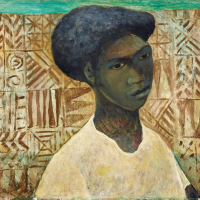5. RAY CROOKE

Ray Crooke is celebrated for his quiet but intensely poignant landscapes of people and their environment. The images of Thursday Island Crooke created in the late 1950s remain amongst the most evocative images in his oeuvre. These compositions have a keen sense of locality, and describe with unprecedented accuracy, this remote region and the unique features that distinguish it.
Crooke joins a long line of artists who dedicated their practice to the examination of lands and life outside of their personal realm. Paul Gauguin (1948-1903), arguably the most notable artist to pursue and document exotic locations, stated:
I am leaving in order to find peace and quiet, to be rid of the influence of civilization. I only want to make simple, very simple art, and to be able to do that, I have to re-immerse myself in virgin nature, see no one but savages, live their life, with no other thought in mind but to render, the way a child would, the concepts formed in my brain and to do this with the aid of nothing but the primitive means of art, the only means that are good and true.1
Almost sixty years later Crooke shared Gauguins incentive, although his documentation of the inhabitants and lifestyle of Thursday Island was far more realistic than his predecessor. Crookes interest in the pacific region was sparked by a four-year stint at an army base. While his contemporaries travelled throughout Europe to further their artistic studies, Crooke returned to the Pacific to gain a tropical re-education of spirituality, kinship, and aesthetic interpretation. Crooke kept a detailed journal containing sketches and passages of island life that provided as the source materials and inspiration for the present work. Central to such intentional ordering of forms towards an aesthetic ideal, is Crookes enduring preoccupation with tonal relationships, contours and silhouettes, and the theatrical juxtaposition of dark against light. He notes, I endeavour to make use of my learnings toward classic forms, decoration, depth, and colour and hang them on a simple acceptable human statement.2
An important early work, Girls Head was featured in Crookes first solo exhibition at Australian Galleries in Melbourne in 1959. The present work is a portrait of a young Kaurareg women who wears a plain round-necked blouse and whose hair sits naturally atop her head. The background surrounding her mimics a heavily patterned piece of fabric painted in red ochres and a lemony beige, whilst green and aqua peak through and ground the work. A faint yellow and red floral pattern is seen as under-painting in the girls neck, a subtle nod to the vibrancy of life Crooke experienced on Thursday Island. The use of contrasting light, shape and pattern, underpin the strength and authenticity of his vision, instilling the work with a powerful sense of mystery and a curious timelessness.
Ray Crooke is an important figure within the fabric of Australian art history. He has harmoniously and carefully modelled a glimpse into a time and place that was far removed from the awareness of most Australians. As James Gleeson notes, he belongs to that rare breed of artists who have subtly changed the way of looking at the world. He has revealed the tropical north as it has never been revealed before. We are in debt to the extent that we now tend to see that part of the country through his eyes and with his vision.3
Footnotes:
1. Paul Gauguin interviewed by Jules Huret, lEcho de Paris, Paris, 1891
2. Crooke, R., Island Journal, Bede Publishing, Brisbane, 2000, p.107
3. Introduction, in Gleeson, J., Ray Crooke, Australian Artist Editions, Collins Publishing, Sydney, 1972, n.p.
Clementine Retallack